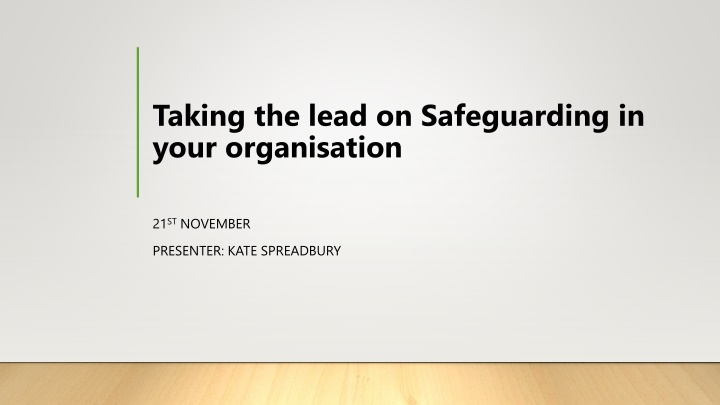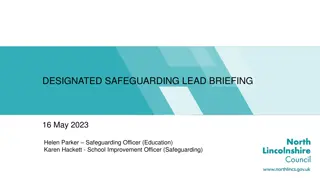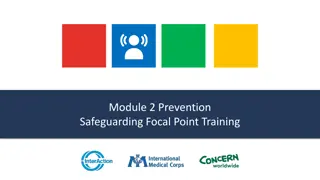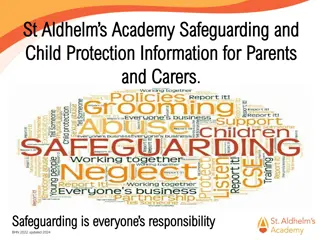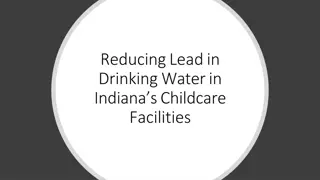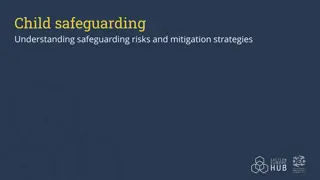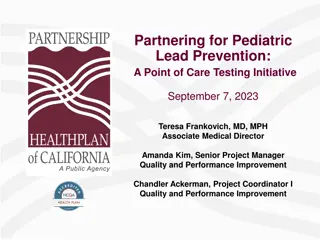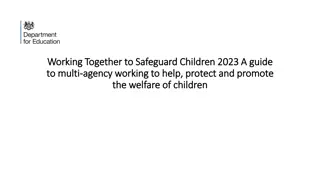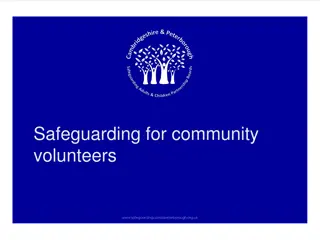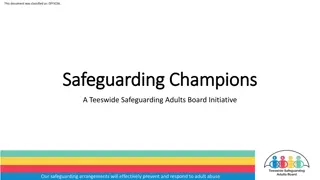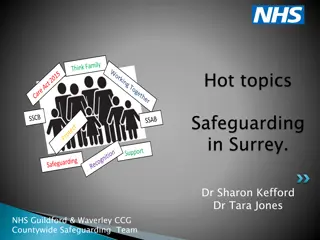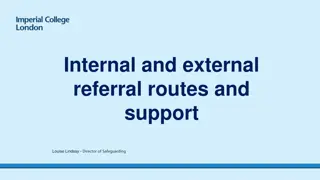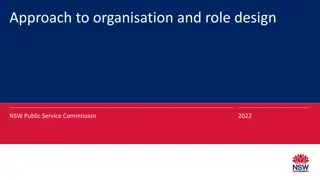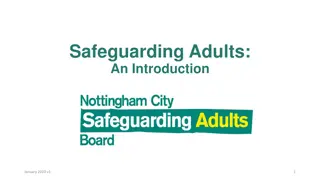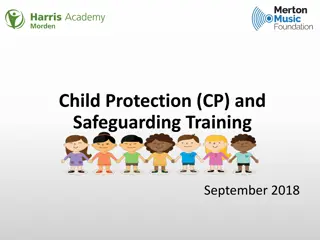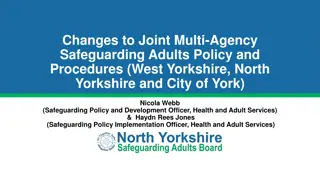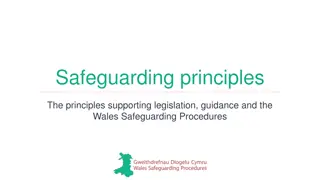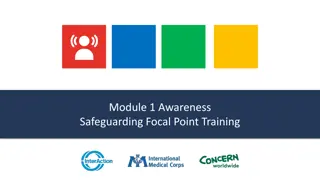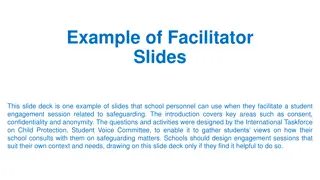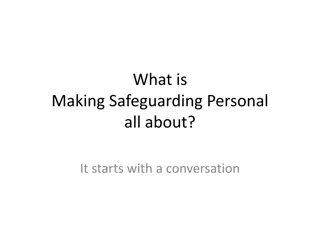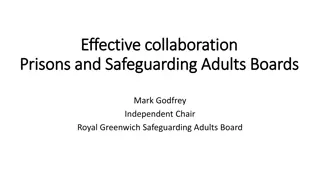Taking the Lead on Safeguarding in Your Organisation - Essential Insights
This session covers the key aspects of being a safeguarding lead, including developing a strong safeguarding culture, empowering staff to raise concerns, and understanding the principles of adult safeguarding. Learn how to build relationships within and outside your organization, know the everyday experiences of your people, and create a supportive environment where everyone feels valued and safe.
Download Presentation

Please find below an Image/Link to download the presentation.
The content on the website is provided AS IS for your information and personal use only. It may not be sold, licensed, or shared on other websites without obtaining consent from the author.If you encounter any issues during the download, it is possible that the publisher has removed the file from their server.
You are allowed to download the files provided on this website for personal or commercial use, subject to the condition that they are used lawfully. All files are the property of their respective owners.
The content on the website is provided AS IS for your information and personal use only. It may not be sold, licensed, or shared on other websites without obtaining consent from the author.
E N D
Presentation Transcript
Taking the lead on Safeguarding in your organisation 21STNOVEMBER PRESENTER: KATE SPREADBURY
What do you need to be a safeguarding lead? What will we cover in this session? What does a good safeguarding culture look like? Developing staff confidence to raise Safeguarding concerns. Using local guidance on referral, caused enquiries and escalation. Using reflection, learning and development opportunities having a learning culture.
Six Principles that underpin everything about adult safeguarding. Empowerment. Proportionality. Prevention. Partnership. Protection. Accountability.
Know your organisation and the people it works with. What do you need to be a safeguarding lead? Relationships- within and outside your organisation. Safeguarding literacy. Legal Literacy. Able to model and contribute to a learning culture.
What is the everyday experience of the people who live and work in your organisation? Strengths? Know your organisation and the people it works with. Any specific risks? History of the organisation and organisational memory. What kind of culture does the organisation have? What are it s values, aspirations, concerns?
What does a good safeguarding culture look like? People feel valued (staff and people using the service). They have time to make relationships with each other. People know what to expect so they can say when this isn t happening. They know what good should look like. They are encouraged and supported to complain/give feedback/ say when things aren t quite right. Staff understand people well enough to know when things aren t right for them. Staff pick up on issues that indicate potential problems / safeguarding concerns (including relationships and health issues). Staff feel empowered to report and act on concerns. Whistleblowers are supported. If safeguarding concerns are picked up, the person at risk is part of early discussions. Advocacy or representation is used as needed.
Within the organisation what are the lines of accountability? Who has oversight? How do they use this oversight? Where do you get your support from? Where can staff and the people who use the service get support from? Who do you know and talk with outside of your organisation? Who is supportive? Who can you go to if unsure? Is there a mutual respect between you? Do you belong to any national or local /regional groups that focus on the promotion of quality of service? Can you ensure that you or the relevant people in your organisation have access to support for example training the trainer networks? Relationships- within and outside your organisation.
Safeguarding literacy. Knowing the people who use your service are staff familiar with how to identify situations which may require a preventative or protective safeguarding response? Make sure policies and procedures are easy to read and understand. Are staff familiar with the procedures? Are staff using them if not why not? Do staff have suggestions as to how they can be more user friendly? Are your policies and procedures consistent with those of the local Safeguarding Adults Board? Look on the local SAB web-page. Is your experience of using those procedures consistent with what the SAB policies and procedures say? Are you familiar with the local resolving professional differences (escalation) procedure?
Article 2 life. Legal Literacy: The Human Rights Act Article 3 dignity. Article 5 legal process. Article 8 family and private life.
Key sections of the Care Act: Section 1 the wellbeing principle Section 42 adult safeguarding duty Section 9 assessment of an adults need for care and support. Section 10 assessment of a carer s need for support. Section 11 refusal of assessment. Section 19 power to meet urgent need without a financial assessment. Sections 67 and 68 Advocacy duties. Legal Literacy.
Who is the decision maker? Supporting assessments if you are not the decision- maker (the Five Principles) Making unwise decisions that may harm yourself needs further exploration*. Using Best Interests decision-making processes. The Mental Capacity Act 2005 (2007). * MCA Code of Practice Paragraph 2.11 as well as undue pressure contemporary experience would add trauma, addiction etc as an undue pressure . The person has capacity, but we cannot walk away without further exploration.
Developing staff confidence to raise Safeguarding concerns. Promote a safeguarding culture. Model the values, attitudes and response needed. Feedback, individual and group discussion, encouraging dialogue all helps it becomes easier to bring up concerns. Encourage complaints from people who use the service. Practice writing up an account of a disclosure or observation. Give guidance what to do if you are concerned about a colleague s behaviour or attitudes. Use case studies good practice in reporting or the impact of poor practice. Set clear expectations about what can happens after a concern is expressed. Give feedback about what happened next whenever you can.
How to refer it varies! Ask for a discussion if you are unsure whether to refer or not. Follow up has the local authority s duty under s42 been agreed? What are the next steps? As a professional and a referrer you retain your duty of care. Are you being asked (or caused ) to undertake an Enquiry? What are the terms of reference for this? How will the person be involved? Is there an agreed timescale? An agreed format? If you think there are risks to the person that have not been understood do you know how to resolve this? Are you familiar with the local Safeguarding Adults Board escalation pathway? Using local guidance on referral and escalation.
To be resilient, an organisation needs to ensure that learning and development is at the heart of all that they do. A learning organisation is one in which: Beliefs, goals and objectives, are underpinned by a set of shared values, principles and behaviours Individuals, teams and the organisation have opportunities to reflect on practice and learn from experience There is an evidence-informed approach to improving practice and managing change, with individual input actively encouraged Challenges provide learning opportunities, rather than lead to individual blame People have the freedom to speak up to raise concerns without feeling compromised, blamed or victimised. Being a learning organisation
Good practice we want to do more of. Prevention. Near miss. One off incident. Multi-agency work. Abuse or neglect including self-neglect. What can we use to learn?
Some learning opportunities In one-to-one supervision. Group supervision case discussion. Section 42 enquiry. Internal lessons learned review. External review. Taking part in a Safeguarding Adult Review or similar.
When something goes wrong .. INDIVIDUALS FEEL ORGANISATIONS FEEL shock shock anger anger fear fear shame and guilt shame and guilt a sense of injustice. a sense of injustice.
Barriers to learning Avoiding recalling a negative experience. Feeling guilty/like a failure. Being blamed /feeling attacked. Not having time or space to think Not knowing what could have been done differently
Both individuals and organisations need Response. Recovery. Resolution.
Opportunity to look at Individual practice Supervision systems Policies and procedures/guidance Workplace culture Relationships with other organisations/external parties including families And more!
What layers can we explore? Individual Inside the organisation What happens around the organisation National context.
Describe what went well. What contributed to the success? Helpful Questions to ask when something goes well. What can you continue to do? What do you need to keep doing well? What one behaviour do you need to keep, how will you keep doing it? How can we share this learning?
Other useful questions for critical incidents What happened? who/what/when/how? Did our procedures/policies help? Are people aware? Using well? Need updating? Did the staff member have the right support/training to deal with this? How did other agencies help or hinder? Feedback from /to other agencies? What do we need to change? Across all layers be pragmatic. How will we make these changes? How will we know the changes have made a difference? What works? What signs we will see that the changes are working?
If staff have been involved in generating the learning, they will be ready to use it. What to do with the learning? Think creatively what are the most effective ways of changing the way we work? Modelling or showing how it is done. Talking about in groups or with individuals. Noticing and appreciating using positive case studies and examples. Check back a while later, what would happen now? Do we need to make more changes, share the learning again?
Some Resources https://www.local.gov.uk/publications/making-safeguarding-personal-what- might-good-look-health-and-social-care-commissioners https://www.nice.org.uk/about/nice-communities/social-care/quick- guides/creating-a-safeguarding-culture https://www.researchinpractice.org.uk/all/news- views/2023/november/prioritising-the-welfare-and-wellbeing-of-yourself-and- others/ https://sword.researchinpractice.org.uk/media/b05o0amd/kfp3-learning- organisation.pdf
